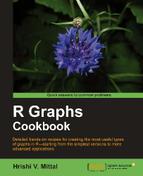For most data analysis we can just use the default fonts for titles. However, sometimes we may want to choose different fonts for presentation and publication purposes. Selecting fonts can be tricky as it depends on the operating system and the graphics device. We will see some simple ways to choose fonts in this recipe.
All you need to try out this recipe is to run R and type the recipe at the command prompt. You can also choose to save the recipe as a script so that you can use it again later on.
The font family and face can be set with the par() command:
par(family="serif",font=2)
A font is specified in two parts: a font family (such as Helvetica or Arial) and a font face within that family (such as bold or italic).
The available font families vary by operating system and graphics devices. So R provides some proxy values which are mapped on to the relevant available fonts irrespective of the system. Standard values for family are "serif", "sans", and "mono".
The font argument takes numerical values: 1 corresponds to plain text (the default), 2 to bold face, 3 to italic, and 4 to bold italic.
For example, par(family="serif",font=2) sets the font to a bold Times New Roman on Windows. You can check the other font mappings by running the windowsFonts() command at the R prompt.
The fonts for axis annotations, labels, and plot main title can be set separately using the font.axis, font.lab, and font.main arguments respectively.
The choice of fonts is very limited if we just use the proxy family names. However, we can use a wide range of fonts if we are exporting our graphs in the PostScript or PDF formats. The postscriptFonts() and pdfFonts() functions show all the available fonts for those devices. To see the PDF fonts, run the following command:
names(pdfFonts()) [1] "serif" "sans" "mono" [4] "AvantGarde" "Bookman" "Courier" [7] "Helvetica" "Helvetica-Narrow" "NewCenturySchoolbook" [10] "Palatino" "Times" "URWGothic" [13] "URWBookman" "NimbusMon" "NimbusSan" [16] "URWHelvetica" "NimbusSanCond" "CenturySch" [19] "URWPalladio" "NimbusRom" "URWTimes" [22] "Japan1" "Japan1HeiMin" "Japan1GothicBBB" [25] "Japan1Ryumin" "Korea1" "Korea1deb" [28] "CNS1" "GB1"
To use one of these font families in a PDF, we can pass the family argument to the pdf() function:
pdf(family="AvantGarde") pdf(paste(family="AvantGarde")
In Chapter 10, Finalizing Graphs, we will see some more practical recipes on setting fonts for publications and presentations.
